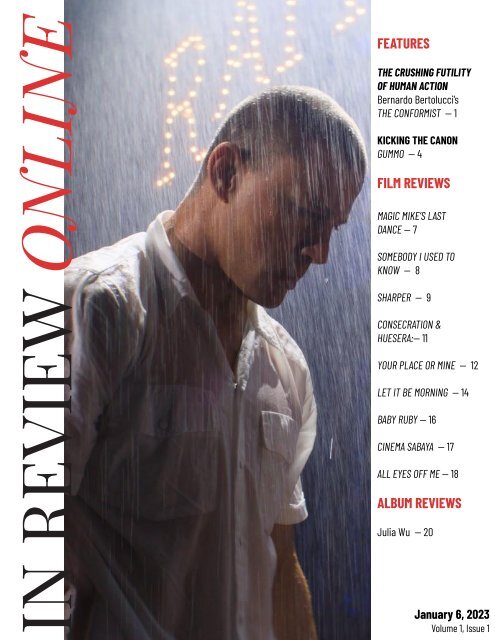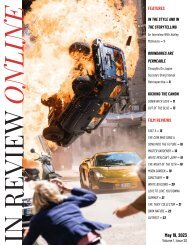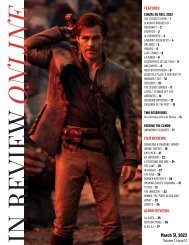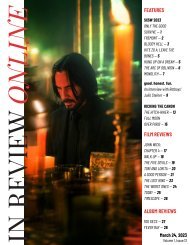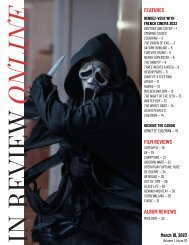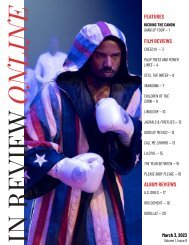InRO Weekly — Volume 1, Issue 6
Create successful ePaper yourself
Turn your PDF publications into a flip-book with our unique Google optimized e-Paper software.
IN REVIEW ONLINE<br />
FEATURES<br />
THE CRUSHING FUTILITY<br />
OF HUMAN ACTION<br />
Bernardo Bertolucci’s<br />
THE CONFORMIST <strong>—</strong> 1<br />
KICKING THE CANON<br />
GUMMO <strong>—</strong> 4<br />
FILM REVIEWS<br />
MAGIC MIKE’S LAST<br />
DANCE <strong>—</strong> 7<br />
SOMEBODY I USED TO<br />
KNOW <strong>—</strong> 8<br />
SHARPER <strong>—</strong> 9<br />
CONSECRATION &<br />
HUESERA:<strong>—</strong> 11<br />
YOUR PLACE OR MINE <strong>—</strong> 12<br />
LET IT BE MORNING <strong>—</strong> 14<br />
BABY RUBY <strong>—</strong> 16<br />
CINEMA SABAYA <strong>—</strong> 17<br />
ALL EYES OFF ME <strong>—</strong> 18<br />
ALBUM REVIEWS<br />
Julia Wu <strong>—</strong> 20<br />
January 6, 2023<br />
<strong>Volume</strong> 1, <strong>Issue</strong> 1
TITANIC<br />
Courting Disaster<br />
There’s a contradiction at<br />
the heart of James Cameron’s<br />
work, and the reason he’s such a<br />
quintessential Hollywood figure is because of, not<br />
despite, that contradiction. Cameron is an artist, but he’s<br />
also a technician; cinema is an art, but also a technology. The<br />
medium has become inextricable from commerce and popular culture partly because of<br />
its unique expense, but also Hollywood has made a conscious effort to promote this idea: Going<br />
all the way back to the silent era, the industry ballooned costs to maintain a feeling of<br />
inaccessibility. When Erich von Stroheim’s Foolish Wives (1922) went wildly over budget, that frustration was<br />
spun into a virtue by an advertising campaign that called it “the first real million dollar picture,” sometimes citing the<br />
specific cost of $1,104,000.
Cameron is part of a lineage, then. Avatar (2009) was developed<br />
alongside the technology needed to make it, and its sequel cost<br />
so much that, according to Cameron, it needed to become “the<br />
third or fourth highest-grossing film in history” just to break<br />
even. Yet both Avatar films are about escaping the world of<br />
industry and capital, returning to a simpler, more natural mode<br />
of living that’s rendered entirely in cutting-edge CGI; the<br />
contradictions between art and technology are immediately<br />
established at their most obvious but also at their most deeply<br />
entangled.<br />
On the other hand, Titanic (1997) establishes these two forces<br />
clearly and separately in its opening scenes. First, there are the<br />
researchers exploring the remains of the famous vessel <strong>—</strong> as<br />
Cameron did himself, for his rendering <strong>—</strong> trying to understand<br />
every forensic detail of the sinking. And then there’s Rose (Gloria<br />
Stuart), the survivor now nearly 101 years old, who dryly remarks<br />
after seeing the researchers' digital recreation: “Of course, the<br />
experience of it was somewhat different.” It’s this human<br />
perspective, rife with deep feeling, that turns a cold copy into<br />
art; those emotions are really what bring the Titanic back to life<br />
for the screen, not all of the precise technical detail.<br />
But when Rose tells her story to the researchers, it doesn’t<br />
exactly transcend that contradiction; her recreation, of course, is<br />
still quite bound up in the conventions of Hollywood storytelling.<br />
Titanic evokes other, “higher” arts both generally <strong>—</strong> in the broad<br />
idea of Romeo & Juliet that it borrows <strong>—</strong> and specifically <strong>—</strong> as<br />
when Jack (Leonardo DiCaprio), the Romeo to Rose’s Juliet (Kate<br />
Winslet, in the past), admires a Monet recreation. But both speak<br />
to its insularity, and all that Jack can say about the painting is<br />
that it has a great “use of color,” but without commenting on how<br />
it is used or to what end. It’s the received wisdom about art<br />
compressed through layers of Hollywood language. This<br />
dedication to “movie-ness,” which runs deep in Cameron’s work,<br />
might reflect a serious limit to his imagination, and at the very<br />
least, caps what he’s able to do. It might seem novel here that the<br />
man is the figure of fantasy for the woman rather than the other<br />
way around, for example, but one character is still reduced to<br />
their function in the emotional life of the other. It’s the same<br />
structure with a few pieces superficially moved around.<br />
Still, Cameron’s use of conventions and tropes is quite conscious,<br />
and he’s found more use for them as his career has gone on<br />
(though their use hasn’t quite reached the point of abstraction in
Titanic that it will in Avatar, where a character is never more than<br />
a loose sketch of a certain type). This could quite easily be<br />
regarded as a cynical move, as thinking in four-quadrant terms<br />
and patronizing his audience, assuming they need the<br />
comfortably familiar story at the core of Avatar to hold their hand<br />
through its digital fantasy world. And while that might be true to<br />
a certain extent, it’s largely because Cameron looks at<br />
storytelling from the vantage of a technician: he builds with the<br />
parts that have been proven to work. The fact that there is still<br />
life in Titanic, that it feels less mechanical than its functional<br />
parts, is surely in some part due to the chemistry between<br />
DiCaprio and Winslet, but there’s more to it than that.<br />
And this is the miracle of Hollywood: that art can form within,<br />
against, the great commercial forces and highly formalized and<br />
abstracted language (which was at an even further remove in the<br />
so-called Golden Age, when Hollywood was creating more<br />
masterpieces than ever). The famous “draw me like one your<br />
French girls” scene evinces some of how this actually happens,<br />
beyond pure mythology. The scene is both obviously sexual <strong>—</strong><br />
Rose asks Jack to draw her naked <strong>—</strong> but it’s also tasteful, one<br />
breast obscured behind the sketchbook, so that it can play as an<br />
awakening of sorts to (generally speaking) young boys without<br />
upsetting parents' sensibilities. It’s also genuinely erotic for both<br />
parties <strong>—</strong> and so too for the adults of both genders whom<br />
Cameron imagines watching. Jack looks but can’t touch, and<br />
Rose not only gets to be seen as desirable and beautiful, but also<br />
gets to feel powerful through her initiation of the act, clearly the<br />
one in control of the situation. All of these threads are playing to<br />
different audiences at once, executed perfectly and woven<br />
together seamlessly so that they create something like texture;<br />
it’s an undeniably dense scene. So even if it’s targeted, to target is<br />
to interpret desire, which in turn says something about people<br />
and society at large, which is the scale such a scene is aiming<br />
for.<br />
Even though Cameron is attuned to his audience, though, he isn’t<br />
bound by their expectations. The “French girls” scene ends with a<br />
fade from a close-up of Rose as she lays naked to a close-up of<br />
her in the present day, bringing an elderly person far closer to<br />
sex than taboo usually allows. She even here expresses her<br />
sexuality <strong>—</strong> it’s she who describes the scene as erotic. This isn’t<br />
exactly something that a studio head or anyone who’s thinking<br />
only in commercial terms would suggest <strong>—</strong> it’s likely not even
something they’d be capable of considering. This is just another<br />
element of Cameron’s auteurist vision. But as we’ve stated, that<br />
vision tends to stay primarily focused on the technical side of<br />
things, and as such, his most obvious Titanic stand-in is lead<br />
researcher Brock Lovett (played by Bill Paxton).<br />
literal-mindedness <strong>—</strong> in Avatar, Pandora is compared to Oz, it’s<br />
supposed to be an escape into the pure fantasy of movies, but<br />
everything within it has a one-to-one real-world analog; the<br />
religion is proven to be scientifically accurate, and that’s what<br />
turns the ship of dreams into scrap metal.<br />
“And this is the miracle of Hollywood: that art can form within, against, the<br />
great commercial forces and highly formalized and abstracted<br />
language… The famous “draw me like one your French girls” scene<br />
evinces some of how this actually happens, beyond pure mythology.<br />
Titanic is arguably told from Brock’s perspective as much as<br />
Rose’s; her character offers an enrichment of his technical<br />
understanding of events, the flashbacks being a combination of<br />
the two. This is likely why there’s so much slippage in Rose’s<br />
telling; from the beginning, she’s describing things that only Jack<br />
would have seen, but that feels like a gentle enough stretching,<br />
or at least a reasonable extrapolation of known narrative. It’s as<br />
soon as the ship hits the iceberg that the film becomes<br />
meaningfully untethered from her perspective, as it’s the details<br />
of the sinking that truly fascinate Cameron. This imposes an<br />
order on even the most chaotic moments: When the last bit of<br />
ship slips beneath the water and hundreds of passengers are<br />
crowded together, trying desperately not to drown, only a few<br />
fleeting seconds are given to panic before Cameron cranes the<br />
camera outward. Mathematical certainty hangs over everything,<br />
slowly and precisely unwinding in the way that it already has; it’s<br />
Cameron’s distance rather than Rose’s proximity that drives the<br />
film, that makes it exciting and, at points, even terrifying.<br />
From his earliest films, Cameron’s interests found him aligned<br />
with strange forces. The Terminator (1984) is crafted exactly in<br />
line with its lead character: ruthless, efficient, and violent (so it’s<br />
not surprising he became the good guy in the sequel). This is<br />
most concrete in Titanic, where the director’s passions, the<br />
things that he’s most excited to commit to film, are quite literally<br />
trying to crush that which is supposed to give them life: Rose<br />
and the love story. Cameron is unable to escape his own<br />
Underneath Titanic lies a tangible, powerful death drive. This is a<br />
story of hubris, of a technical marvel too big and too ambitious.<br />
It’s not only that the shipping company’s director (Jonathan<br />
Hyde), for the sake of better press, pressured the Captain<br />
(Bernard Hill) into making the ship go faster, which caused it to<br />
sink; in some sense, it’s the idea itself that the Titanic was<br />
unsinkable, most explicitly seen in its lack of lifeboats. They tried<br />
to create something that transcended the material reality of its<br />
construction, which is as good a description of art as any,<br />
especially art made in a commercial context like Hollywood. The<br />
biggest movie and the biggest ship, both courting disaster, both<br />
flying too close to the sun (or, more aptly, sailing too close to the<br />
ice). It’s an irresistible parallel, and one Cameron surely wouldn’t<br />
miss in such a metatextual film. It’s easy to imagine his famously<br />
huge ego seeing this as a challenge to overcome, but the film<br />
can’t help but face failure by the facts of its story. That’s why the<br />
scene where the musicians keep playing through the destruction<br />
and the terror is so moving <strong>—</strong> it imagines the worst-case<br />
scenario, where the ship or the movie starts to fall apart entirely,<br />
and decides to keep going for its own sake.<br />
Of course, this Titanic didn’t sink <strong>—</strong> the film became the biggest<br />
Hollywood movie since Gone With The Wind (1938). And it’s maybe<br />
for that reason that the excesses indulged in Cameron’s Avatar<br />
films merely embrace the concept of contradiction without<br />
demonstrating much urge to interrogate it or any sense of<br />
possible failure. Yet some part of Cameron can’t quite let Titanic
go, as we’re here writing this on the eve of the film’s third<br />
re-release, this time updated with 4K HDR and HFR. And in the<br />
intervening years, he’s featured in several documentaries poring<br />
back over the details, updating his model of the sinking with all<br />
the discoveries made since (another was announced only a few<br />
days ago). In the ironically titled Titanic: The Final Word with<br />
James Cameron (2012), he and his team quite crassly speculate<br />
on hypotheticals where everyone could have survived; Cameron’s<br />
idea is to put them onto the iceberg since that wasn’t going to<br />
sink. The event is stripped of all the weight and reality the film<br />
was supposed to imbue the catastrophe with. At the end of<br />
Titanic, Cameron’s stand-in Lovett says: “[For] three years I<br />
thought about nothing but Titanic, but I never got it; I never let it<br />
in,” yet he seems to be trying to push it back out.<br />
There’s some sense that not only could Titanic fail, but that<br />
maybe it did; and these contradictions can only lead to<br />
implosion. Terminator 2: Judgement Day (1991) is all about fluidity<br />
and transformation: emotionally, as the Terminator learns to be<br />
more human, and technologically, with the liquid metal villain<br />
demonstrating the new possibilities of CGI. But even then, the<br />
Terminator can only understand why people feel <strong>—</strong> he can’t feel<br />
himself, and there’s no promise that the apocalyptic future that<br />
these characters have come back from has been prevented, even<br />
though the material conditions that created it have been<br />
changed. Cameron could only locate a small glimmer of hope.<br />
And so in Titanic, which is bound by history, trying to reach back<br />
and in some way bring this long-dead past back to life seems<br />
totally insurmountable.<br />
Maybe that’s because Cameron holds himself to the standards of<br />
Hollywood, limiting himself to what works within a false<br />
hegemony. But by speaking through that language <strong>—</strong> and drawing<br />
attention to it through the friction of the framing and central<br />
story <strong>—</strong> he shows its limits; he shows a film fighting against itself<br />
and losing. The past escaping into the void. The film's final shot<br />
starts as a POV, winding through the Titanic, toward Jack, as if<br />
we’ve finally gone back. But then Rose walks in front of the<br />
camera, and we’re put at a remove, showing whose perspective<br />
we’re seeing. And anyway, this isn’t even a memory but a dying<br />
dream, one that soon enough fades into white forever. For<br />
someone who sees the world as literally as Cameron does, there<br />
is a deeper tragedy to the end of living memory. Experience and<br />
emotion exist in the cracks of material reality, and so once they<br />
are gone, they are profoundly so <strong>—</strong> there is no wreckage left to<br />
search through.<strong>—</strong> ESMÉ HOLDEN
Like a lot of American enterprises of today, the Grammy Awards<br />
are both considered high prestige and met with low expectations.<br />
We all know that they’re going to disappoint us <strong>—</strong> just as surely as<br />
the sun will rise, the Recording Academy will get things terribly<br />
wrong <strong>—</strong> and yet we tune in anyway because… well, we’ll take<br />
what we can get. Naturally, the Grammys got a lot of things<br />
wrong this year. But let’s begin with a few things that they got<br />
right.<br />
GRAMMYS<br />
Title title title<br />
First, this Grammys skirted the major catastrophes. Can you<br />
imagine if Machine Gun Kelly won Best Rock Album? Or if DJ<br />
Khaled won Album of the Year? Apologies to Khaled, but he owes<br />
all six of his nominations to that one Jay-Z verse. (The Recording<br />
Academy didn’t believe in him, but hey, at least God did.) We could<br />
debate whether Bonnie Raitt’s “Just Like That” was really the<br />
Song of the Year, but it’s probably even easier to agree that<br />
GAYLE’s “abcdefu” was a complete blip and profoundly lucky just<br />
to be nominated. (We can even pretend it never was!) Beyoncé<br />
rightfully took home Best R&B Song for “CUFF IT,” a timeless<br />
track that really deserved more nominations. Nile Rodgers <strong>—</strong><br />
whose slick guitar work elevates the song from bop to classic<br />
bop <strong>—</strong> accepted the award on Bey’s behalf (as even queens aren’t<br />
immune to L.A. traffic). In his speech, Rodgers described “CUFF<br />
IT” as “the most organic thing that ever happened to me.” That’s<br />
saying something, given how many hits the man has under his<br />
belt.<br />
Sunday night’s ceremony also saw Beyoncé become the most<br />
decorated Grammy winner of all time, nabbing four additional<br />
trophies to bring her lifetime count to a record 32. In addition to<br />
Best R&B Song, she took home awards for Best Traditional R&B<br />
Performance, Best Dance/Electronic Album, and Best<br />
Dance/Electronic Recording. These made for historic wins, but<br />
the night may still have been somewhat deflating for her: she<br />
failed to secure Album of the Year (an award she’s never won,<br />
despite three nominations), losing the prestigious prize to Harry<br />
Styles’ far inferior Harry’s House. (Only Bey could make history<br />
and still get snubbed in the same evening.) In fact, of her 32<br />
Grammys, only is for a major all-genre category: her 2010 Song of<br />
the Year win for “Single Ladies (Put a Ring On It).”
THE<br />
HARDER<br />
THEY<br />
COME<br />
Perry<br />
Henzell<br />
The post-independence era was a turbulent<br />
one for the small island nation of Jamaica.<br />
Having gained freedom from the British in 1962,<br />
the following decade of economic growth was also<br />
marked by increased inequality and escalating urban<br />
violence. It’s against this backdrop that writer-director Perry<br />
Henzell and co-writer Trevor Rhone decided to bring the story of<br />
notorious Jamaican outlaw Ivanhoe Martin <strong>—</strong> known by his nickname Rhyging<br />
(the Jamaican Patois word for "raging") <strong>—</strong> to the screen. After being shot dead by police<br />
In 1948, Rhyging, who is often described as the original "rude boy," grew into a sort of folk<br />
legend for many poor Jamaicans who found in him a rebellious antihero who stood up against the<br />
colonial and capitalist order <strong>—</strong> a complex admiration not dissimilar to the one enjoyed by early-20th-century<br />
European illegalists like Jules Bonnot.<br />
Henzell and Rhone's script <strong>—</strong> which began life under the working title Rhyging before they settled onthe implicit fatalism of The Harder<br />
They Come <strong>—</strong> updated the rudy's story to the 1970s, and the two decided to cast reggae singer Jimmy Cliff in the lead role. Cliff, who<br />
had no prior acting experience outside of school plays, had seen his star rise throughout the back half of the '60s, and his 1970 single<br />
"Vietnam" even earned the praise of Bob Dylan, who called it the best protest song he’d ever heard. The musician's natural charisma in<br />
the lead role wouldn't be the only thing to contribute to the first Jamaican feature film's lasting legacy, however, as its iconic<br />
soundtrack <strong>—</strong> featuring tracks from Desmond Dekker, Toots and the Maytals, and Cliff himself <strong>—</strong> is widely credited with popularizing<br />
reggae music internationally.<br />
Composed for the film, Cliff's infectious title song formed a defiant yet grim counterpoint to the aspirational "You Can Get It If You<br />
Really Want," which plays over the opening credits, anticipating the tragic end to the badman protagonist's nihilistic rebellion. "So as<br />
sure as the sun will shine / I'm gonna get my share now, what's mine / And then the harder they come / The harder they fall, one and all,"<br />
goes the song's chorus, the fictionalized Ivanhoe Martin <strong>—</strong> "Ivan" for short <strong>—</strong> unwittingly prophesying his eventual downfall during a
ecording session. But like the films that inspired it <strong>—</strong> Django, which makes an appearance during a rowdy screening in Kingston; The<br />
Wild Bunch; Bonnie and Clyde <strong>—</strong> The Harder They Come trades in stylishly gritty action fireworks, even as it anticipates the bleak<br />
fascination it, or more specifically its main character, will inspire. For instance, when the fugitive Ivan attempts to gun down his<br />
former boss, José (Carl Bradshaw), chasing him through a Kingston slum, he is quickly surrounded by laughing children, eager to get a<br />
glimpse of the charismatic desperado.<br />
Even more obvious is Henzell's framing during the Django screening: youthful, curious faces, illuminated by the silver screen, look on in<br />
awe as Franco Nero's titular character guns down rows of menacing, red-hooded enemies with a machine gun, collectively erupting in<br />
cheers as his adversaries' dead bodies hit the dusty desert ground. When an audience member gets a little too caught up in the<br />
narrative and worries out loud about Django's survival, the brash José mockingly asks him, "You think hero can dead 'til the last reel?"<br />
<strong>—</strong> a glib seen-it-all-ism that, in a moment of sly subversion, will prove to be just as prophetic as the title track.<br />
Ivan's transformation from awkward "country bwoy" to murderous gunslinger is a radical one. Arriving in Kingston with wide-eyed<br />
naïveté and half a dozen bags <strong>—</strong> the entirety of his earthly possessions <strong>—</strong> he is immediately robbed blind by a vulturous street vendor<br />
and forced to face his brusque, city-dwelling mother with nothing but vague hopes of making it as a singer. Unable to stay with her, he<br />
eventually finds a job doing menial work for a Christian minister (Basil Keane), but soon begins pursuing the preacher's young female<br />
charge, Elsa (Janet Bartley). After spending most of his time reading comic books and issues of Playboy, not to mention using the<br />
church to rehearse his secular tunes, the bohemian Ivan is dismissed, and an argument with a former colleague escalates into a knife<br />
fight, transforming Ivan's eyes from mellow and friendly to gleefully sadistic for the first time.<br />
After being sentenced to a brutal whipping by a judge for slashing his opponent's face, Ivan becomes fully determined to make it as a<br />
reggae artist, but exploitative music industry practices, as well as a resentful record executive, move him to accept a side hustle as a<br />
drug runner. The runs go smoothly at first, but when an approaching police officer triggers a flashback to the corporal punishment he<br />
received, the traumatized Ivan guns down the cop, effectively sealing his fate. It's not only the moment that gives birth to the near-
mythological black hat, a kind of trauma response which leaves<br />
the charmingly gawky Ivan behind to make way for the legendary<br />
dual-wielding gunman, but also where the film itself transforms<br />
from a neorealist travelogue into a guns-blazing crime thriller.<br />
though he was widely reported on as he shot his way into folk<br />
hero status, photographs of Rhyging are rare, and the few that<br />
exist have deteriorated to the point of indecipherability, his<br />
image largely living on in the cultural imagination.<br />
Before the third-act eruption, The Harder They Come simmers<br />
with rich textures and barely-contained sensuality, perhaps best<br />
exemplified by a sequence during which the religious ecstasy of<br />
a church congregation resembles the more carnal ecstasy of sex<br />
<strong>—</strong> sweaty churchgoers contort their faces as they shake, twist,<br />
and even tumble over in suggestive elation. Elsa, in the midst of<br />
the wildly gyrating mass, suddenly has blissful sexual fantasies<br />
of herself and Ivan, their naked bodies covered in the wet of a<br />
surrounding ocean. It's a provocative scene, one where lust<br />
seems to trigger something akin to a spiritual vision, and the<br />
sparkle and shine of her daydream lend the images a<br />
paradisiacal quality, the two lovers becoming Adam and Eve-like<br />
figures in the young romantic's mind. But even the film's sexuality<br />
becomes more lurid following Ivan's inciting murder. Far removed<br />
from Elsa's picturesque visions, Ivan's newly-discovered<br />
ruthlessness leads him into a tryst with José's girlfriend <strong>—</strong> before<br />
engaging the police in a deadly shootout dressed only in his<br />
underwear. In fact, even though he's on the run, his hedonistic<br />
hunger grows so insatiable that he throws caution to the wind,<br />
and instead opts to steal cars, buy fancy clothes, and even pose<br />
for a photoshoot. Pistols in hand, Ivan swaggers in front of the<br />
camera, mimicking Spaghetti Western hard-asses and building<br />
his own myth in the process.<br />
The photoshoot plays an interesting role in the film. For one, it<br />
epitomizes just how brazen Ivan has become, refusing to lay low<br />
and later sending his stylish portraits to newspapers. For<br />
another, it interrogates history, self-invention, and the very<br />
medium of photography itself. Ivan flaunts his elusiveness by,<br />
paradoxically, making himself more visible <strong>—</strong> he spray-paints "I<br />
WAS HERE BUT I DISAPPEAR" all over Kingston, taunting the police<br />
<strong>—</strong> mirroring contemporary news reports of Rhyging's criminal<br />
activities, dramatically describing him as a "phantom killer" with<br />
a propensity for disappearing as quickly as he appeared. Even<br />
Cliff's portrayal almost functions as yet another instance of<br />
Rhyging suddenly reemerging after having, in a sense,<br />
"disappeared into the dark," as the Kingston-based Daily Gleaner<br />
so aptly described his seemingly miraculous vanishing act after<br />
committing a murder. The dissemination of images has been an<br />
important element through which history is understood, and<br />
there's a lot of ink to be spilled about how these processes tend<br />
to favor certain groups of people over others <strong>—</strong> photographs of<br />
Billy the Kid or Jesse James are far better preserved, their moral<br />
character being no less dubious than Rhyging's. As such, The<br />
Harder They Come stands not just as a fiery crime film, but also<br />
as a necessary corrective to a neglected photographic history of<br />
Jamaica.<br />
“[This] callback to the<br />
grindhouse flicks of the ‘70s<br />
offers up the most respectful<br />
portrait of sex workers the<br />
big screen has seen in ages.<br />
The film was a sensation upon its Jamaican release, with<br />
showtimes regularly being overrun by enthusiastic filmgoers<br />
who, in an era of worldwide political upheaval and widespread<br />
anti-government sentiment, were thrilled to see the famous<br />
criminal finally come to life in a way he hadn't been allowed to<br />
before. Even though the impact of its soundtrack has somewhat<br />
overshadowed Henzell's debut, it hasn't lost an iota of its radical<br />
power. Henzell himself has downplayed Rhyging's status as a folk<br />
hero <strong>—</strong> in a 1988 television interview, he said, "[Rhyging] was just<br />
seen as a guy who created a lot of excitement… He's a character,<br />
and people recognized that" <strong>—</strong> but his visceral take on the story<br />
nonetheless ensured that the myth will live on for generations to<br />
come. <strong>—</strong> FRED BARRETT
HARD BOILED<br />
John Woo<br />
For this writer, a personal cinematic pet peeve is when characters fire guns only for the bullets to seem to dissipate, never hitting<br />
anything. John Woo is, perhaps more than any other filmmaker from his generation, aware that bullets destroy shit. Every time a gun<br />
goes off, walls erupt, windows explode, bodies are ripped up and go flying <strong>—</strong> ridiculous, yes, but there’s a weight here, a sense of<br />
gravity, of consequence. This sense of consequence is why the insane action of his Hong Kong films remains poignant while most<br />
modern blockbusters feel artificial. Hard Boiled, the absolute apogee of action cinema, is riddled with bullets, shredding bodies and<br />
erupting into oddly pleasing sparks like fireworks as they slam into doors, walls, the husks of cars <strong>—</strong> splatter and sparkles.<br />
"Give a guy a gun, he thinks he's superman. Give him two and he thinks he's God." Hard Boiled is chockablock with guys with guns, and<br />
even more with gunshots. Here, the Godly Chow Yun-fat stars as an indefatigable police sergeant while a baby-faced Tony Leung<br />
Chiu-wai plays an intrepid undercover cop who has risen high in the ranks as a triad assassin. Across the film’s two hours, their paths<br />
meet and pleat until they are, in the end, inextricable, uniting to shoot it out with seemingly hundreds of bad guys with big guns,<br />
destroying a hospital but saving the day <strong>—</strong> and a bunch of babies.<br />
Woo was one of the last masters of analog spectacle, an artist from an era before computers made the impossible boring and<br />
depleted action cinema of anything tactile. Woo's camera is swoony and swervy, moving curvaceously, the director switching things<br />
up, shot to shot, with the most dexterous editing in cinema. Today, in a post-Wick world, the decently skilled directors working in the<br />
genre utilize the medium and employ wide shots with only rare cutting, showcasing the choreography and capping things off with CG<br />
blood. Woo cuts a lot. In his sequences, geography is logical, bullets follow their trajectory and hit what they're aimed at, bodies fall<br />
and stay there. Take, for instance, the scene in Hard Boiled where Chow slides down a railing while dual-wielding guns and shooting
enemies. Woo doesn't film this to show off the stunt, but instead employs a staggering amount of cuts <strong>—</strong> almost 20 times in 20<br />
seconds. Chow is smooth in this sequence while surrounded by bodies hitting the floor; sometimes slowly, sometimes quickly, always<br />
violently.<br />
But Woo is a master of melodrama as much as he is of action. As with his lyrical and elegiac The Killer and his later heroic Hollywood<br />
efforts Broken Arrow and the flat-out awesome Face/Off, and even in his unfairly-derided Mission: Impossible II (which, while neutered,<br />
is still replete with Woo-ist touches), there's a theme of duality, of partnership and friendship and the depths of bromance, on which<br />
the extraordinary set-pieces of Hard Boiled are founded. Chow and Leung have better chemistry than any leads in any romantic<br />
comedy of the last 20 years, with riotous raillery and a palpable sense of unity and determination to get the baddies. (It’s easy to go<br />
back and forth between The Killer, which is more soulful and tragic, and Hard Boiled, which is a triumphant, more formally daring<br />
affair. In true Woo fashion, they are an inextricable pair, two embodiments of the same passions and vision.)<br />
Woo’s films are also always concerned with morality, but there are no cumbersome lessons; the juxtaposition between cop and<br />
criminal, good and evil, redemption and damnation is gunmetal gray. All of which is to say, there's poetry in Woo’s violence, as when<br />
Chow plugs a baby's ears with cotton and lights up so many men, all of their blasted bodies bursting into blood and viscera as the<br />
baby gazes with gleaming goo-goo eyes. So while Chow can deliver a stony-eyed glare as well as anyone, Woo unburdens his films of<br />
the self-severity and stoicism of modern action. Instead, he makes friendship and masculinity and morality and heroism and the<br />
ravaging of human bodies by metal projectiles oddly, alluringly beautiful. <strong>—</strong> GREG CWIK
FILM REVIEWS<br />
MAGIC MIKE’S LAST DANCE<br />
Steven Soderbergh<br />
“What are your plans for Act Three?” asks one character of<br />
Channing Tatum’s Mike about the show he’s directing in Magic<br />
Mike’s Last Dance, the third overall and second Steven<br />
Soderbergh-directed entry in the male-stripper series created by<br />
Soderbergh in collaboration with writer Reid Carolin and (in this<br />
case) producer Gregory Jacobs. The reply? “We’re gonna have<br />
one.” In one of the most self-reflexive films of Soderbergh’s<br />
career, this line stands out for its honesty about both the<br />
aimlessness and the underdog charm of the project. The film <strong>—</strong><br />
Soderbergh’s first to be released in theaters after five<br />
consecutive streaming releases <strong>—</strong> is rife with anxieties about the<br />
pressures of pleasing both crowds and producers, and the result<br />
is a work whose eccentricities are both frustrating and<br />
fascinating.<br />
Last Dance opens with Mike bartending a fundraising event held<br />
by wealthy, emotionally fragile recent divorceé Maxandra<br />
Mendoza (Salma Hayek). Mike’s furniture business has fallen<br />
victim to the latent economic anxieties that have always<br />
marked this series. After catching wind of Mike’s former<br />
profession, Maxandra entices him into a private after-hours<br />
dance that both sets the film on its path and, unfortunately, is<br />
where the movie peaks. The promise of the Magic Mike films is<br />
largely that they tap into pleasures that the American cinema<br />
has all but left behind <strong>—</strong> sex appeal, yes, but also the capturing<br />
of physical performance, the expressiveness of seeing movie<br />
stars do things with their bodies that most of us can’t (“A body<br />
in motion is always sexy as fuck,” goes one line). The movie is at<br />
its best when hewing closer to that promise, and the extended,<br />
intimate pas de deux between these two middle-aged sex<br />
symbols is where it does so most memorably.<br />
It’s the aftermath of that scene, in which Hayek convinces<br />
Tatum to follow her to London for a month with a mysterious<br />
promise of employment, where things start to get rocky. In a<br />
story apparently inspired by the genesis of Tatum’s real-life<br />
Magic Mike London stage show, Maxandra enlists Mike to direct<br />
a male stripper revue in the stuffy West End theater left to her<br />
in the divorce. Soderbergh can always be counted on to<br />
attempt a new narrative experiment or genre riff with each<br />
picture, and the “let’s put on a show” musicals of the ‘30s <strong>—</strong> Gold<br />
Diggers of 1933, Footlight Parade <strong>—</strong> are a fitting inspiration.<br />
Outside the theater, however, the movie shifts into something<br />
few would have expected from the franchise: a gentle, languid<br />
family drama.<br />
As the emotional attachment between Mike and Maxandra<br />
grows, her precocious teen daughter Zadie (Jemelia George, her<br />
first screen role) and mysterious butler Victor (Ayub Khan-Din,<br />
terrific in his first since Stephen Frears’ Sammy and Rosie Get<br />
Laid in 1987) emerge as the film’s two major
FILM REVIEWS<br />
supporting characters. The movie’s insistence on low-keyness<br />
feels refreshing <strong>—</strong> this is surely one of the lowest-stakes studio<br />
releases in recent years <strong>—</strong> if not particularly rewarding.<br />
Soderbergh can’t be blamed for not attempting to recreate the<br />
nonstop bacchanalia that has made XXL something of a modern<br />
classic, but Last Dance too often hits the exact pitfalls that film<br />
eschewed. Soderbergh is at his best when his material expands<br />
the range of his talents <strong>—</strong> here, he feels constrained by a script<br />
that, worse than being fairly undercooked, plays to the opposite<br />
of his talents.<br />
The family drama feels strangely thin and unmotivated <strong>—</strong> we<br />
wonder why we’re spending so much time with these people,<br />
and Last Dance struggles to give us much of an answer.<br />
Director/cinematographer/editor Soderbergh also feels<br />
stylistically reined in here <strong>—</strong> the last time he absconded to<br />
Europe for a sequel, he synthesized the continent’s aesthetic<br />
influences for the bravura formal achievement of Ocean’s<br />
Twelve. Despite his career-long inspiration from the likes of<br />
Roeg, Boorman, and Lester, the London setting doesn’t<br />
invigorate in the same way. Most disappointingly, the treatise<br />
on female desire and empowerment that runs through the<br />
series gets its most didactic treatment here, spelled out in<br />
dialogue or in Zadie’s book-report narration on the societal<br />
function of dance rather than embodied in its performances.<br />
“[This] callback to the<br />
grindhouse flicks of the ‘70s<br />
offers up the most respectful<br />
portrait of sex workers the<br />
big screen has seen in ages.<br />
It’s telling that this movie finds Mike moving, somewhat,<br />
from the role of performer to director, as Last Dance is<br />
largely about the struggle to create art in a world hostile to<br />
it, where reliance on a wealthy benefactor is the only<br />
option left to the artist. Indeed, the movie’s most potent<br />
wish fulfillment may be Soderbergh’s own <strong>—</strong> imagine if you<br />
got your money from Salma Hayek instead of the likes of<br />
David Zaslav. The show, when it comes, is worth the wait,<br />
heartwarming and dazzling in equal measure, and topped<br />
with a truly perilous-feeling, rain-drenched duet from<br />
Tatum and dancer Kylie Shea. In moments like these, the<br />
talent involved becomes undeniable <strong>—</strong> it’s nice to be in the<br />
hands of a director who actually knows how to fill out a<br />
widescreen frame, or how to judiciously employ handheld<br />
or close-ups for emotional effect. Tatum, likewise, once<br />
again proves himself to be one of the most talented,<br />
reliable, and selfless stars of his generation. In the end,<br />
however, the diminishing returns of Magic Mike’s Last Dance<br />
may be its most lasting commentary on the worlds of art<br />
and commerce <strong>—</strong> one just keeps trying to get the magic<br />
back however one can, until the compromises and<br />
disappointments met along the way become the story<br />
itself. <strong>—</strong> BRAD HANFORD<br />
DIRECTOR: Steven Soderbergh; CAST: Channing Tatum, Salma<br />
Hayek, Caitlin Gerard, Gavin Spokes; DISTRIBUTOR: Warner<br />
Brothers; IN THEATERS: February 10; RUNTIME: 1 hr. 52 min.<br />
SOMEBODY I USED TO KNOW<br />
Dave Franco<br />
A Type A careerist finds her life spinning out of control after the<br />
man she’s long harbored feelings for announces his intentions of<br />
marrying a younger woman, inspiring her to recklessly insert<br />
herself into their relationship to try and split the happy couple<br />
apart. She feigns friendship with the bride-to-be, while secretly<br />
undermining the couple every chance she gets – and the whole<br />
thing explodes, spectacularly, the weekend of the wedding. Fans<br />
of romantic comedies will likely recognize this as the premise of<br />
1997’s My Best Friend’s Wedding, which has now been ported over,<br />
with only a handful of tweaks, to the new Amazon-premiering<br />
Somebody I Used to Know, from actor-turned-director Dave<br />
Franco. It’s a bit of theft the film even cops to with Kiersey<br />
Clemons’ Cassidy, the younger bride in this love triangle, asking<br />
Alison Brie’s Ally if she’s not, in fact, attempting her own version
FILM REVIEWS<br />
of the Julia Roberts film after the latter elbows her way into the<br />
wedding party. It’s an acknowledgment on the film’s part of how<br />
derivative this all is, but also a slight upending of expectations.<br />
Everyone on screen seems to recognize Ally’s motives, they just<br />
refuse to intervene, and even humor her attempts to sow chaos.<br />
Is it merely apathy on the film’s part or recognition that, perhaps,<br />
this union isn’t meant to go forward?<br />
Aspiring documentarian Ally left her hometown of Leavenworth,<br />
Washington (a quaint community modeled after a German village)<br />
for Los Angeles ten years earlier and, like so many before her,<br />
she sold out for the relative ease and quick money of producing<br />
reality television. After the show she created – some kind of<br />
cooking competition where everyone sleeps with one another – is<br />
abruptly canceled by the network, she tucks tail, retreating to<br />
Leavenworth to try and figure out her next step and get some<br />
TLC from her mother, Libby (Julie Haggerty). While drinking her<br />
sorrows away at a local bar, Ally has a chance encounter with<br />
Sean (Jay Ellis), the guy she spurned for her big city dreams, and<br />
they immediately fall back into old habits, which here amounts to<br />
public drunkenness and harassing the town’s reindeer population.<br />
It’s the kind of magical evening that finds them enjoying one<br />
another’s company well past sunrise,<br />
yet, after Ally initiates a kiss at the end of the night, she senses<br />
Sean tensing up. Has she misread the situation or is there<br />
something else?<br />
The “something else” is Cassidy, Sean’s fiancée, who he failed to<br />
mention the whole time he and Ally were out all night,<br />
shotgunning beer and liquid cheese. Ally inadvertently crashes<br />
the pre-wedding festivities after stopping by Sean’s house and<br />
feels embarrassment and confusion: why would Sean not<br />
mention he’s days away from getting married… unless he still has<br />
feelings for her? Improbably roped into serving as videographer<br />
for the wedding by Sean’s family (she does make documentaries,<br />
after all), Ally's presence only puts further strain on Sean and<br />
Cassidy’s relationship. Cassidy’s not an idiot and recognizes the<br />
disruptive influence of having Sean’s ex hovering around, but she<br />
treats the whole thing like a game of chicken, playing things cool<br />
while waiting to see who’s going to blink first.<br />
The central question of why anyone would invite this sort of<br />
temptation into an already fraught occasion like a wedding is<br />
never directly answered, and while some of that is merely<br />
shoddiness on the film’s part, it does lend the film a useful level<br />
of tension, providing an undercurrent of uneasiness to otherwise
FILM REVIEWS<br />
rote sitcom hijinks. Far from an innocent here, Sean repeatedly<br />
sends out mixed signals: Outwardly distancing himself from Ally<br />
while failing to intervene once it becomes clear her presence is a<br />
distraction, then sneaking off so they can talk about his fears<br />
and anxieties, the stuff he can’t bring up with Cassidy. A late<br />
revelation even calls into question how much bumping into Ally<br />
that first night was actually happenstance on his part. Yet, in<br />
keeping with its overall approach, which can either be<br />
interpreted as generosity or indecisiveness, the film refuses to<br />
come down on Sean as either a ditherer or a cad. Like seemingly<br />
everyone here, he’s just working through some things.<br />
That lack of clarity is most noticeable with Ally, whose actions<br />
are outwardly psychotic (in the grand tradition of The Onion<br />
headline “Romantic-Comedy Behavior Gets Real-Life [Person]<br />
Arrested”), but the film is ultimately too timid to offer much of an<br />
opinion about her either. Alternating between Machiavelian<br />
schemer (she searches out Cassidy’s parents and surreptitiously<br />
invites them to the wedding even though they’ve been cut out of<br />
her life for good reason) and a sympathetic ear for both Sean and<br />
Cassidy, it can be difficult to track Ally’s objectives on a<br />
scene-by-scene basis. Does Ally actually love Sean enough to<br />
break up his marriage, or does he just remind her of a time when<br />
she had hope for her future? Have her years producing reality TV<br />
hardened her to messy human emotions and rendered her thirsty<br />
for artificial drama? And is this all merely a passing fad, not<br />
coincidentally timed to a lull in her career?<br />
Co-written by Franco and Brie (married in real life, the actress<br />
previously appearing in the filmmaker’s Airbnb thriller, The<br />
Rental), the film is caught between good-natured bawdiness and<br />
touchy-feely earnestness. In any given moment, we might get a<br />
running gag about Ally walking in on her 60-something mother<br />
having sex, or the film indulging Brie’s professed love of nudism,<br />
or a heart-to-heart about Sean’s need for control stemming from<br />
his abandonment issues, or the suggestion that Cassidy’s desire<br />
to remain on tour with her rock band mirrors Ally’s own<br />
professional aspirations. And the film’s unwillingness to go for<br />
blood, always quickly absolving its characters of their relative<br />
transgressions, ends up leaving a lot of meat on the bone. Not<br />
vicious enough to work as cringe comedy yet too irreverent and<br />
loaded up with groan-worthy pop culture references to be truly<br />
bittersweet, Somebody I Used to Know – like the characters<br />
themselves – just feels perpetually torn. <strong>—</strong> ANDREW DIGNAN<br />
DIRECTOR: Dave Franco; CAST: Alison Brie, Jay Ellis, Kiersey<br />
Clemons, Danny Pudi, Haley Joel Osment; DISTRIBUTOR: Amazon<br />
Prime Video; STREAMING: February 10; RUNTIME: 1 hr. 46 min.<br />
SHARPER<br />
Benjamin Caron<br />
In the course of that rich history of films about con artists, the<br />
appeal has almost always been to watch largely amoral<br />
professionals execute their perfect plans in order to strip some<br />
rich jerk of their money. What Sharper presupposes is… maybe it<br />
isn’t? The result is a mostly diverting couple of hours, but one<br />
unfortunately marred by the fact that it’s all so bizarrely square.<br />
The film is broken into chapters, each of which, sort of, focus on<br />
an individual character. First, we have Tom (Justice Smith), who’s<br />
working at a bookstore when he’s taken with one of his<br />
customers, Sandra (Briana Middleton). After a requisite<br />
meet-cute and a nice date (plus an entire opening sequence <strong>—</strong><br />
probably accidentally, but still <strong>—</strong> that plays almost as a carbon<br />
copy of Clarence and Alabama meeting in True Romance), there’s<br />
a lovely montage showing their burgeoning romance. And, as it<br />
turns out, Tom also comes from money <strong>—</strong> a lot of it.<br />
We then bounce back in time to see Sandra’s introduction to Max<br />
(Sebastian Stan). He lifts her up out of addiction and parole<br />
officer problems, training her to become an expert confidence<br />
trickster. At this point, we’re also introduced to Madeline<br />
(Julianne Moore), who might be Max’s lover but is instead<br />
pretending to be his mother. You see, she’s dating Richard<br />
Hobbes (John Lithgow), a big wheel at some hedge fund who also<br />
happens to be Tom’s father. You see where this is all headed: The<br />
whole thing is perfectly cromulent. The time-jumping narrative<br />
helps Sharper to maintain a modicum of suspense throughout,
FILM REVIEWS<br />
and all the actors are game in their respective roles. Stan and<br />
Moore, in particular, have some actual chemistry; it’s just a<br />
shame that they’re sidelined for large chunks of the story.<br />
Lithgow also oozes just the right amount of ick, but he also exits<br />
the narrative too early and leaves behind Middleton and Smith, a<br />
pair who simply aren’t interesting enough on their own either as<br />
a precious dupe or an audience-surrogate tour guide to the world<br />
of the long con.<br />
ddd<br />
There’s competently executed tension here, but director<br />
Benjamin Caron ultimately doesn’t have a ton up his sleeve. A<br />
graduate from years of television, there are the usual<br />
prestige-TV stylistic tricks <strong>—</strong> shallow focus, flourishy<br />
monochrome scenes, etc. <strong>—</strong> but it’s rarely surprising. And at his<br />
worst, on a couple of occasions Caron even gets right in the way<br />
of his actors, such as in a brief scene of Moore and Stan having a<br />
celebratory dance in an empty bar that would have been far<br />
more effective if it wasn’t ill-advisedly broken up by coverage.<br />
Even setting all that frustrating technical craft aside, though,<br />
Sharper fails not because it’s generic, but rather because its<br />
attempt at a smidgen of novelty is so damn boring in execution.<br />
Who comes to a caper movie for a story of someone gaining a<br />
conscience and feeling sorry about conning people? The<br />
approach is anathemic to the subgenre and sets expectations it<br />
has no intention of meeting, not to mention it’s simply no fun at<br />
all. <strong>—</strong> MATT LYNCH<br />
DIRECTOR: Benjamin Caron; CAST: Julianne Moore, Sebastian<br />
Stan, Justice Jesse Smith, John Lithgow; DISTRIBUTOR: Apple<br />
TV+ / A24; IN THEATERS: February 10; STREAMING: February 17;<br />
RUNTIME: 1 hr. 56 min.<br />
CONSECRATION & HUESERA<br />
Christopher Smith | Michelle Garza Cervera
FILM REVIEWS<br />
OLD REVIEWS NEW RELEASES<br />
SERIOUSLY RED<br />
Gracie Otto<br />
“Filled to the brim with a host of classic Dolly tunes and boasting<br />
a delightful central performance by Boylan, Seriously Red puts a<br />
new spin on the oft-told tale of finding oneself by letting its<br />
protagonist quite literally lose herself in another role. Set<br />
amongst a kooky cast of celebrity wannabes <strong>—</strong> including Rose<br />
Byrne as an Elvis impersonator and Bobby Cannavale as a former<br />
Neil Diamond <strong>—</strong> the film wears its outsized heart on its sleeve,<br />
but its earnestness thankfully never comes across as cloying or<br />
insincere.” <strong>—</strong> MATTIE LUCAS<br />
DIRECTOR: Gracie Otto; CAST: Krew Boylan, Rose Byrne, Bobby<br />
Cannavale; DISTRIBUTOR: Gravitas Ventures; IN THEATERS &<br />
STREAMING: February 10; RUNTIME: 1 hr. 38 min.<br />
ATTACHMENT<br />
Gabriel Bier Gislason<br />
DIRECTOR: Gabriel Bier Gislason; CAST: Sofie Gråbøl, David<br />
Dencik, Ellie Kendrick, Josephine Park; DISTRIBUTOR: Shudder;<br />
STREAMING: February 9; RUNTIME: 1 hr. 45 min.<br />
THE BLUE CAFTAN<br />
Maryam Touzani<br />
SWALLOWED<br />
Carter Smith<br />
“The film moves so languidly that any potentially devastating<br />
emotional blows have been softened: The first time Halim and<br />
Youssef even begin to verbally profess their love for one another,<br />
we’re already halfway through the coy film. One could call it being<br />
deliberate with your pacing, but since not much has really<br />
occurred beforehand <strong>—</strong> other than what took about two<br />
sentences to sum up <strong>—</strong> it’s more Touzani stalling the drama<br />
before it actually has time to begin complicating itself.” <strong>—</strong> PAUL<br />
ATTARD<br />
DIRECTOR: Carter Smith; CAST: Jena Malone, Cooper Koch, Jose<br />
Colon; DISTRIBUTOR: Shudder; STREAMING: February 14;<br />
RUNTIME: 1 hr. 33 min.<br />
DIRECTOR: Maryam Touzani; CAST: Lubna Azabal, Saleh Bakri,<br />
Ayoub Messioui; DISTRIBUTOR: Strand Releasing; IN THEATERS:<br />
February 10; RUNTIME: 2 hr. 3 min.<br />
16
ALBUM REVIEWS<br />
IDFK<br />
Julia Wu<br />
Simply put: Julia Wu has established<br />
herself as one of the most consistent<br />
artists of the decade so far. The<br />
Australian-Chinese singer-songwriter has<br />
put out an album every year since 2019<br />
(and more before that) <strong>—</strong> the mixed<br />
Mandarin and English 5 am in 2019, its<br />
entirely English version 5 pm in 2020, 2622<br />
in summer 2021, and now IDFK in winter<br />
2022 <strong>—</strong> and each of them has been a<br />
smooth, groovy R&B delight. Highlights<br />
during that run include the indelible hook<br />
of “One in a Billion,” the hazy “Sunset,” and<br />
the cozy, rainy day single Better,” plus<br />
many more tracks that fully vibe without<br />
sacrificing their character.<br />
IDFK’s title might seem to suggest an<br />
under-promise, but its content is that of an<br />
excellent R&B record that easily lives up to<br />
the standard of Wu’s last few projects. “If<br />
Only You,” for instance, is the exact kind of<br />
song that tends to grace the middle<br />
section of a Wu tracklist, but it’s so velvety<br />
and honestly sung that the familiarity<br />
justifies itself. Other tracks do try styles<br />
that she hasn’t explored quite as much: On<br />
opener “I Can’t,” Wu tosses off the line “I<br />
could be everything that you’ll ever need”<br />
over refreshingly dancey production, and<br />
“The<br />
One,” with its funky electric guitar and<br />
disco synth shimmers, is one of the<br />
artist’s most upbeat songs to date. In<br />
contrast, single “Late Night Cruising” is<br />
slow and sultry, vocals drawn out around<br />
the bends in the road: “Make a little wish,<br />
I’ll take you up high / Breaking through the<br />
clouds, we’ll feel the sun rise.”<br />
The title of the eponymous track<br />
downplays its lyrical content, where Wu<br />
reaches up into her falsetto over muted<br />
electric guitar to declare that she “feel[s]<br />
like staring into you forever.” A lot of her<br />
songs capture this sensation, that of<br />
being caught up in feelings for another<br />
person to the point where the music<br />
communicates almost a physical texture<br />
being caught up in feelings for another<br />
person to the point where the music<br />
communicates almost a physical texture<br />
to her desire. With the exception of the<br />
bouncy, slightly more cynical “Retail<br />
Therapy,” the tracks on IDFK are focused<br />
on attraction and romance, and that’s one<br />
of the reasons why, despite its consistent<br />
sound, Wu’s music doesn’t feel stale. Even<br />
when the hooks are breezy, her songs are<br />
deeply felt, and her vocal performances<br />
operate as such passionate confessions<br />
that they make every line feel important.<br />
It’s no surprise, then, that the overall<br />
production on the album is warm, packed<br />
with lush vocal layering, and neatly<br />
balancing elegance and casual<br />
conversation. IDFK may only consist of<br />
eight tracks, but it accomplishes a lot in<br />
that limited space. There are a few<br />
immediate discography highlights, some<br />
familiar tracks that ground the set as a<br />
distinctly Julia Wu project, and enough<br />
quality and variety to hopefully pull in new<br />
fans too. Not every, and nary a, prolific<br />
musician is able to reliably pair quantity<br />
with quality <strong>—</strong> so when an artist does<br />
manage to deliver every time, even if only<br />
over a period of time, it’s even more<br />
important for us listeners to celebrate. <strong>—</strong><br />
KAYLA BEARDSLEE<br />
LABEL: ChynaHouse Digital Co. RELEASE<br />
DATE: December 2


